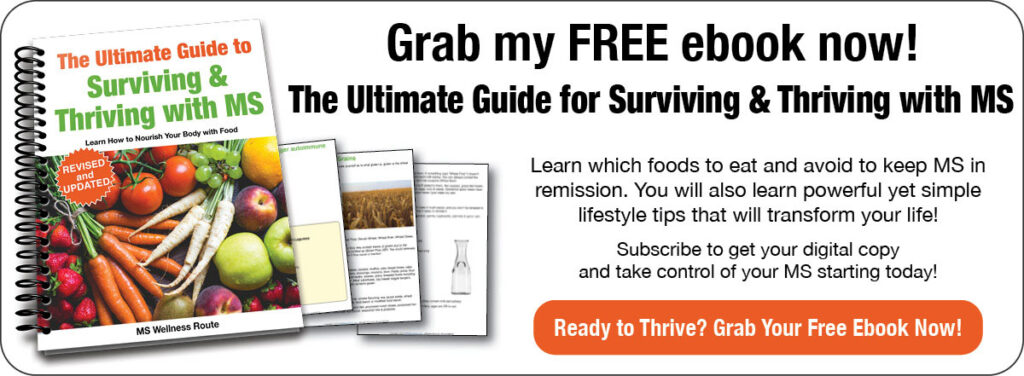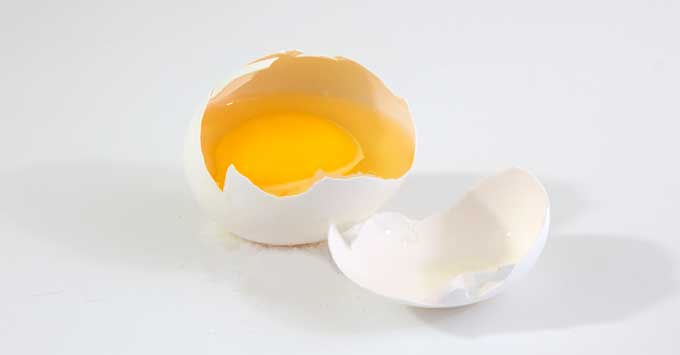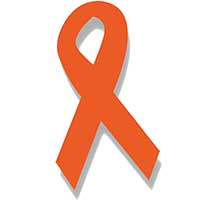Last Updated on January 27, 2025 by Cathy

Eating a diet of whole foods is beneficial for everyone. But it’s especially important for people with multiple sclerosis (MS). Conventional doctors don’t always agree with this, my neurologist told me “diet doesn’t work” to manage MS.
It was a good thing I didn’t listen to him. Once I started eating real food and not processed food I stopped having flares, previously I had about 2-3 each year. Even Dr. Terry Wahls was able to reverse her secondary progressive MS by changing her diet. She went from a tilt recline wheelchair to riding her bike within 18 months.
Not everyone will see such a dramatic result as she did. But being able to stop the progression should be your number one goal. Hopefully, you will also see your symptoms starting to reverse. Completely changing your diet and giving up your favorite foods can seem overwhelming. The Western diet leads to heart disease, type 2 diabetes, obesity, and some cancers. This diet is a highly inflammatory diet and should be avoided.
Environmental Factors
Researchers found 233 variations in the human genome that put a person at a higher risk for MS. They also found a gene variant on chromosome X which is the sex chromosome. Women have two X chromosomes and men only have one. This could explain why more women have MS compared to men.
If you do have a predisposition for MS it doesn’t mean you’re destined to have it. Your genes only count for 5-10% of the risk of MS. The other 90-95% of the risk is your environment. What you eat, your stress level and the toxins around you all play a part.
Possible triggers to MS:
- Diet (processed foods, refined sugar, refined carbs, food allergies, etc.)
- Infections (bacterial overgrowth, parasites, viruses, and yeast overgrowth )
- Environmental Toxins (heavy metals, mold, pesticides, plastics, etc.)
- Chronic Stress (especially emotional stress)
- Genetics (you can’t change your genes but you can change your gene expression by living a healthy lifestyle)
What you put in your mouth every day will either fight disease or it will feed it. By removing the food that causes inflammation it will give your body a chance to heal. Like the saying goes “you are what you eat.”
Processed foods have antibiotics, pesticides, preservatives, sugar, hydrogenated oils, and unrecognizable words. They kill the good bacteria in your gut, including inflammatory oils, and refined sugar. Sugar also feeds bacteria, parasites, fungi, and yeast overgrowth (Candida).
Instead of stopping for a fast-food burger made with antibiotics, corn-fed meat. And french fries cooked in a highly processed oil. Eat a grass-fed burger wrapped in organic lettuce. Add homemade sweet potato fries cooked in a healthy fat like coconut oil.

Heal Your Leaky Gut
A leaky gut happens when the lining in the gut begins to open. It then allows undigested food particles to pass through. The immune system sees them as invaders and creates antibodies to attack. Once your body sees these as an invader every time you eat that particular food item your body has a bad reaction.
Even “healthy” foods can cause food sensitivities. You need to pay attention to what you eat and how your body reacts. Here are some common food sensitivities:
- Gluten
- Dairy
- Grains
- Legumes (peanuts, soy)
- Eggs
- Nightshades (eggplants, peppers, tomatoes)
- Nuts
- Chocolate
- Shellfish
Remove Food Sensitivities

Sometimes it can take real detective work to figure out which food item is causing you problems. Try an elimination diet where you remove certain foods for at least one month, two months is even better. Then reintroduce them back one at a time, Wait a few days before reintroducing another food.
I have been sensitive to eggs my entire life. Even as a small child, I didn’t like eggs because they always gave me gut pains. But, I always accepted this as “normal” and continued to eat them in baked goods. Little did I know it was harming my body.
I eventually stopped eating eggs and tried an elimination diet. This is when I discovered I was sensitive to tomatoes and sweet peppers. I didn’t have an immediate reaction like I did with the eggs. Instead, it was the next day when I woke up and noticed my face had broken out.
Sometimes it can be really hard to figure out which food is causing the problem. This is when you may need to get tested. It’s best to speak with your doctor as to which test is best for you. Unfortunately, these tests are expensive and they aren’t always accurate.
I struggled for months trying to figure out what was causing a rash on my face. After getting tested it showed I’m also highly sensitive to coconut and arugula. Plus moderately sensitive to avocados and tuna. I may have slowly figured it out. But, I would have NEVER figured out the arugula, testing a dark leafy green never crossed my mind.
Repair Your Gut
Once you’ve removed the foods that are causing you to harm it’s time to start healing your gut. Bone broth is excellent for sealing your gut lining. Also, eat fermented foods for probiotics and fiber to help feed the good bacteria. Eat a huge variety of vegetables, Dr. Terry Wahls recommends 6-9 cups each day.
Dr. Terry Wahls recommends 3 cups of each:
- Dark leafy greens
- Colorful all the way through
- Sulfur (asparagus, broccoli, cabbage, onions, etc.
Don’t be afraid to eat fruit! They are high in antioxidants, fiber, minerals, phytonutrients, and vitamins – everything you need to heal.
Quick Links To Information In This Post:
How To Tell If You Have Candida
Tips To Heal Your Leaky Gut
What Is The Wahls Protocol?
Eat a nutrient-dense, anti-inflammatory diet that includes antioxidants. Choose organic as mulch as possible to avoid pesticides. If that’s a problem only buy organic if it is on the Environmental Working Group’s Dirty Dozen list.
Foods to include (choose organic as much as possible):
- Vegetables
- Fruit (berries are best)
- Healthy fats
- Wild-caught fatty fish like salmon
- Grass-fed meats
- Pasture-raised poultry (chickens eat grains so make sure it’s GMO-free and soy-free)
- Nuts and seeds
- Herbs like cinnamon, garlic, ginger, oregano, turmeric, etc.
What is the Best Diet for MS?
There really isn’t a “perfect” diet for MS, it really depends on your body. It’s best to start with a base diet like the Paleo diet or The Wahls Protocol then adjust the diet to fit YOUR needs.
After one year of following the Wahls Protocol and not seeing any improvements, I started paying attention to my body. That’s when I realized I had severe yeast overgrowth.
I stayed on the Wahls Protocol but adjusted it by eating fewer carbohydrates. I also temporarily avoided healthy foods like fermented foods. Three months later I began to notice my symptoms starting to reverse like my heat intolerance.
As you’re improving your diet and removing trigger foods it’s also important to work on other factors. Such as removing infections, getting good quality, exercising, and managing your stress. If you’re struggling contact a functional medicine provider for help.
It’s also important to stay positive and believe that you WILL heal. ❤️

All information is for informational and educational purposes only. It is not to be construed as medical advice or instruction. Please consult your physician or a qualified health professional on any matters regarding your health.
Free Wellness Library!
Subscribe for free and I’ll send you the password to my secret library filled with many printables for your wellness journey.
Want to remember this health tip? Pin it to your favorite Pinterest board!

Resources:





